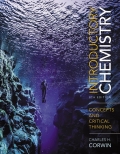
Concept explainers
(a)
Interpretation:
Whether the fermentation of sugar is a physical or a chemical property is to be stated.
Concept introduction:
The change in the physical property of a substance is known as a physical change, which is reversible in nature.
The change in the chemical property of a substance is known as a chemical change, which is irreversible in nature.
(b)
Interpretation:
Whether the dissolution of ethanol in gasoline is a physical or a chemical property is to be stated.
Concept introduction:
Chemical reactions are the rearrangement of atoms, molecules, or ions to form other chemical substances. Chemical changes are of two types; physical change and chemical change.
The change in the physical property of a substance is known as a physical change, which is reversible in nature.
The change in the chemical property of a substance is known as a chemical change, which is irreversible in nature.
(c)
Interpretation:
Whether the freezing of ethylene glycol is a physical or chemical property is to be stated.
Concept introduction:
Chemical reactions are the rearrangement of atoms, molecules, or ions to form other chemical substances. Chemical changes are of two types: physical change and chemical change.
The change in the physical property of a substance is known as a physical change, which is reversible in nature.
The change in the chemical property of a substance is known as a chemical change, which is irreversible in nature.
(d)
Interpretation:
Whether the burning of ethanol with a light blue flame is a physical or chemical property is to be stated.
Concept introduction:
Chemical reactions are the rearrangement of atoms, molecules, or ions to form other chemical substances. Chemical changes are of two types: physical change and chemical change.
The change in the physical property of a substance is known as a physical change, which is reversible in nature.
The change in the chemical property of a substance is known as a chemical change, which is reversible in nature.
Want to see the full answer?
Check out a sample textbook solution
Chapter 3 Solutions
EBK INTRODUCTORY CHEMISTRY
- You are given a hammer, a battery, a bulb, wires and switch.(a) How could you use them to distinguish between samples of metals and non- metals?(b) Asses the usefulness of these tests in distinguishing between metals and non-metals?arrow_forwardClassify each change as physical or chemical. (a) the rusting of iron(b) the evaporation of fingernail-polish remover (acetone) from the skin(c) the burning of coal(d) the fading of a carpet upon repeated exposure to sunlightarrow_forwardClassify each property as physical or chemical. (a) the tendency of silver to tarnish(b) the shine of chrome(c) the color of gold(d) the flammability of propane gasarrow_forward
- Determine whether each of the following represents a physical property or a chemical property: (a) Chlorine gas has a greenish-yellow tint. (b) The density of water at 4°C is 1.000 g/mL. (c) Hydrogen gas is very flammable. (d) Aluminum is a solid at 25°C. (e) Water is colorless and odorless. (f) Lemon juice tastes sour. (g) Gold does not tarnish. (h) Copper cannot be decomposed.arrow_forwardClassify each of the following as a physical change or a chemical change. (a) Touching a lit candle to hydrogen soap bubbles gives an explosion. (b)Heating water in a flask produces moisture on the glass. (c) Combining two colorless solutions gives a yellow solid. (d) Pouring vinegar on baking soda produces gas bubbles.arrow_forwardClassify each property as physical or chemical. (a) the tendency for platinum jewelry to scratch easily(b) the ability of sulfuric acid to burn the skin(c) the ability of hydrogen peroxide to bleach hair(d) the density of lead relative to other metalsarrow_forward
- Classify each change as physical or chemical. (a) A balloon filled with hydrogen gas explodes upon contactwith a spark.(b) The liquid propane in a barbecue evaporates away becausesomeone left the valve open.(c) The liquid propane in a barbecue ignites upon contactwith a spark.(d) Copper metal turns green on exposure to air andwater.arrow_forwardFor each of the following cases, state whether the density of the object increases, decreases, or remains the same:(a) A sample of chlorine gas is compressed.(b) A lead weight is carried up a high mountain.(c) A sample of water is frozen.(d) An iron bar is cooled.(e) A diamond is submerged in water.arrow_forward(a) Under one set of conditions, the substances in A and B mix, and the result is depicted in C. Does this represent a chemical (b) Under a second set of conditions, the same substances mix, and the result is depicted in D. Does this represent a chemical (c) Under a third set of conditions, the sample depicted in C changes to that in D. Does this represent a chemical or a physical change? (d) After the change in part (c) has occurred, does the sample have different chemical properties? Physical properties? ra physical change? a physical change?arrow_forward
- Classify each change as physical or chemical. (a) the explosion of gunpowder in the barrel of a gun(b) the melting of gold in a furnace(c) the bubbling that occurs when you mix baking soda andvinegar(d) the bubbling that occurs when water boilsarrow_forwardThe following pairs of substances represent heterogeneous mixtures. For each pair, describe the steps you would follow to separate the components and collect them. Explain. (a) sugar and sand (b) iron filings and sand (c) sand soaked with oilarrow_forwardWhich of the following statements describe physicalproperties and which describe chemical properties?(a) Iron has a tendency to rust. (b) Rainwater inindustrialized regions tends to be acidic. (c) Hemoglobinmolecules have a red color. (d) When a glass of wateris left out in the sun, the water gradually disappears.(e) Carbon dioxide in air is converted to more complexmolecules by plants during photosynthesis.arrow_forward
- Chemistry: Matter and ChangeChemistryISBN:9780078746376Author:Dinah Zike, Laurel Dingrando, Nicholas Hainen, Cheryl WistromPublisher:Glencoe/McGraw-Hill School Pub Co
